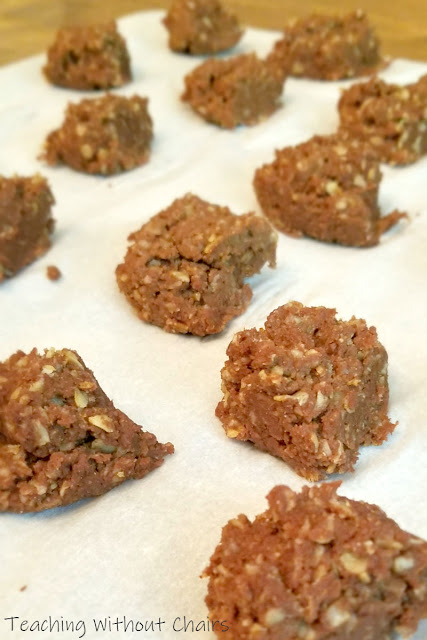Chemistry Class: Intro to Atoms - Homeschool Science Chemistry
This is the first lesson in the homeschool science Chemistry Class I am putting together for elementary and middle school aged students! Today's topic is Introduction to Atoms! Click HERE to see all the other lessons too!
These lessons are designed to be "open and go," so you can grab your supplies (have your kids help!), print the lesson and read it as you go or just read from a tablet or laptop with your kids!
Supplies:
PART 1 Supplies (on the right of the image above):
* Periodic Table (You can download a free one from PBS here)
* two cups of water
* food coloring
* microwave (I suggest pre-heating about 1/2 cup of water in a mug and setting it out with your other supplies.)
PART 2 Supplies (on the left of the image above):
* mixing bowl
* sauce pan
* 3 cups quick oats
* 2 cups sugar-free syrup (or just use sugar)
* 1/2 cup almond milk (or just use milk)
* 1/2 cup coconut oil (or butter)
* 1/2 cup creamy peanut butter
* 1/2 cup unsweetened cocoa powder
* 1 tablespoon vanilla
* stovetop
* parchment or wax paper
Goals:
At the end of this lesson, students will be able to...
1- Explain what an atom is.
2- Put the phases (solid, liquid, and gas) in order from {phase where the atoms move the fastest} to {phase where the atoms move the slowest.}
2- Describe two ways that you can make atoms move faster.
Lesson:
Part 1:
Read: Atoms are the basic building blocks of matter, just like an individual LEGO brick is the basic building block of everything in a LEGO world.
There are about 118 different kinds of atoms, just like there are different sizes and shapes of basic LEGO bricks. You can see all the different atoms on a Periodic Table.
Look at a Periodic Table, especially the first 20 elements. Are any of them familiar?
Read: These different atoms combine to make all matter in our universe! Hydrogen and oxygen combine to make water! Hydrogen, carbon, and oxygen combine to make sugar. Combine hydrogen, carbon, and oxygen in a different way, and you have a fat. Atoms combine to form molecules. We'll look more at specific atoms and molecules throughout this class. Today we're going to focus on general atomic and molecular behavior.
Let's start by putting a couple drops (2-3) of food coloring into one cup of water. What happens?
The molecules of food coloring are wiggling in between the molecules of water. Atoms and molecules are constantly moving--enough that eventually the food coloring and water will be completely mixed up.
The fun thing about food coloring in water is that you can see the exact path it takes as its molecules wiggle in between molecules of water. How do you think we could speed this process up?
We could mix the molecules up with a spoon or we could heat them--the hotter atoms and molecules get, the more energy they have, and the faster they move!
Let's see what would happen if we added food coloring to hot water! Heat some water in the microwave (or pour hot water out of your mug) and then add food coloring it. Did it spread faster or slower than in the cooler water?
Atoms and molecules move faster when they are hotter. This is easy to see in liquids like the water, but what about solids? Are the atoms in the solid table moving? Discuss.
Yes, the atoms in solids like the table ARE moving! But they are so close together and moving so slowly that you cannot tell. Let's think about ice. Ice is a solid, but what happens if it gets too hot? It melts into a liquid. What happens if the liquid gets too hot? It boils into a gas. Atoms and molecules in a gas move faster than in a liquid, and atoms and molecules in a liquid move faster than in a solid.
Let's do another experiment to watch how heating atoms and molecules can make them change from solids to liquids.
Part 2:
Place the oatmeal in the mixing bowl and set it aside.
Measure all the other ingredients into the saucepan and try to stir it.
There are a lot of solids in this mixture! It would take a very long time to stir all these molecules together. But if we add a little heat, the atoms and molecules start speeding up and stir much more easily.
** Use adult supervision -- most house fires begin on stoves! **
Place the saucepan on a stove at medium heat and stir constantly until it starts to boil.
Optional Discussion: Have you ever seen an egg or a piece of bread melt? Every atom, molecule, and solid you can see has two very important temperatures: a melting point and a combustion point. The melting point is the temperature at which the molecules are moving so quickly that it will change from a solid to a liquid. The combustion point is the temperature at which a substance will interact with oxygen in the air and ignite (or burn)! Eggs and bread have a lower combustion point than melting point, so as you cook them (and their temperature rises) they will burn before they melt. They will never get hot enough to melt on Earth because they will burn (or combust) first! Peanut butter, coconut oil, and cocoa have a lower melting point than combustion point, so if you heat them slowly they will melt before they burn. If they get hot enough they can still burn! Fun fact: peanut oil will ignite at about 600 degrees F!
Once the mixture begins to boil, you will notice that all the solids have melted into liquids. The molecules are moving quickly in this mixture and are quite hot!
Quickly pour the hot cocoa mixture over the oatmeal, and stir it thoroughly.
As the mixture cools, the molecules have less energy and move more slowly. The mixture is becoming solid again.
Use spoons to scoop cookies of the mixture onto the parchment paper. Once it is completely cool, enjoy the chemistry experiment! You can also place the cookies in the fridge or freezer to harden more quickly.
Review/Final Discussion:
1- What is an atom?
2- What is a molecule?
3- Which phase (solid, liquid, or gas) do atoms and molecules move the fastest in?
Which phase do they move the slowest in?
4- Describe two ways that you can make atoms move faster.
***
This is the first lesson in my Atoms & Molecules Chemistry Class for homeschoolers! Click HERE to get the rest!
And if you're looking for more homeschool unit studies, be sure to check out our growing collection here!
Happy Educating,
Carla & the kids who don't sit still!
























0 comments